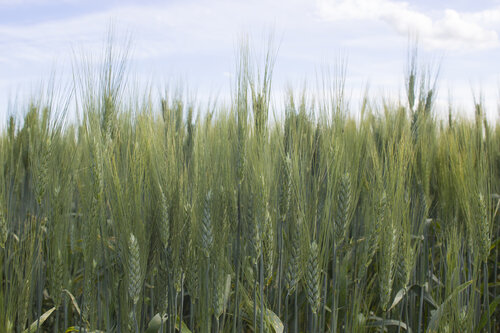Breeding Improved Canada Western Amber Durum Cultivars

Canada is the largest durum wheat exporter in the world. Canada Western Amber Durum (CWAD) is the gold standard for quality, which makes Canada a preferred supplier of durum wheat in high-quality markets. To maintain this advantage in the international market and to increase farm income from durum, wheat breeders are developing varieties with higher yield and improved disease resistance.
“When we do breeding, we always want to keep as many good traits as we can in one variety. It’s not possible, but that’s the target,” says Yuefeng Ruan, a wheat breeder from Agriculture and Agri-Food Canada. Over 81% of the durum acreage on 5-year average in Western Canada was occupied by the varieties developed at the Swift Current Research Development Centre where Ruan works.
The biggest threat to durum production is Fusarium head blight (FHB). Fusarium fungus can produce deoxynivalenol (DON), a mycotoxin that’s a health risk for humans and animals. Ruan has been working on developing high yielding durum varieties with similar quality profiles to AC Strongfield that also have intermediate resistance to FHB. Currently, CWAD varieties are susceptible to moderately susceptible to FHB.
He says durum already has quite good genetic resistance to many diseases, such as rusts (leaf, stem, and stripe), common bunt, and loose smut. He wants to maintain the current levels of resistance to those diseases while he focuses on FHB resistance.
Last year, Ruan registered AAC Donlow, which represented a significant improvement in FHB resistance over Strongfield (30% less FHB and 17% less DON).
“Farmers are always looking for high-yielding varieties,” explains Ruan. “They’re looking for FHB resistance and better performance on drought tolerance. AAC Donlow really gives farmers a good option.” It will be available in three years through Canterra Seeds.
This spring, Ruan’s new line, DT2009 was put forward for registration. It’s the first durum wheat line with intermediate resistance to FHB, which Ruan calls a huge improvement. DT2009 is high yielding with protein levels equal to Strongfield. It has medium plant height, strong straw strength, and resistance to all rusts.
Another focus of Ruan’s research is to improve defence against insects, including wheat stem sawfly and orange wheat blossom midge.
Midge tolerance in all wheat varieties comes from the Sm1 gene, which increases the level of phenolic acid in the wheat kernel and kills wheat midge larvae if they start feeding on a wheat kernel. Ruan’s AAC Weyburn is the first high-yielding CWAD variety to have both Sm1 gene and solid stem, which makes it resistant to both wheat midge and wheat stem sawfly.
In the remaining three years of the current funding cycle, Ruan will continue to develop varieties with higher yield. He says he has not yet reached his goal of 14% greater yield than Strongfield, but he has some lines in his breeding program that he expects will meet that target.
He’s also working on new traits, such as quick dry down and improved tolerance to environmental threats like cold, drought, and heat. “It’s difficult to protect against the environment,” he says.
He also warns that climate change brings new disease threats. “FHB is a good example of that,” he explains. “Ergot is another example. It didn’t used to be an issue, but it’s becoming an issue. So ergot resistance is becoming a target in my breeding program.”
This Wheat Cluster project received funding from Agriculture and Agri-Food Canada through the AgriScience Program, which is part of the Canadian Agricultural Partnership, a federal, provincial, territorial initiative. The project also received funding from Alberta Wheat Commission, Saskatchewan Wheat Development Commission, Manitoba Crop Alliance, and Western Grains Research Foundation.
Read the project description: CLICK HERE.